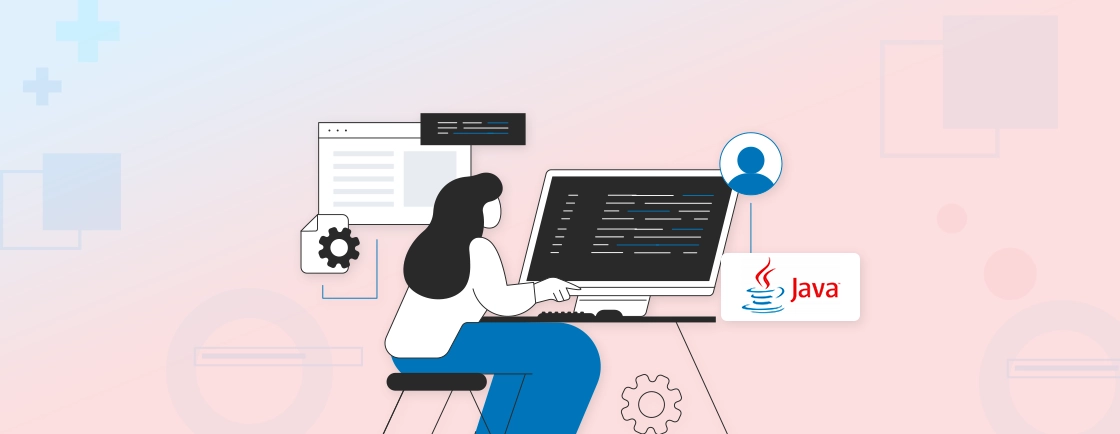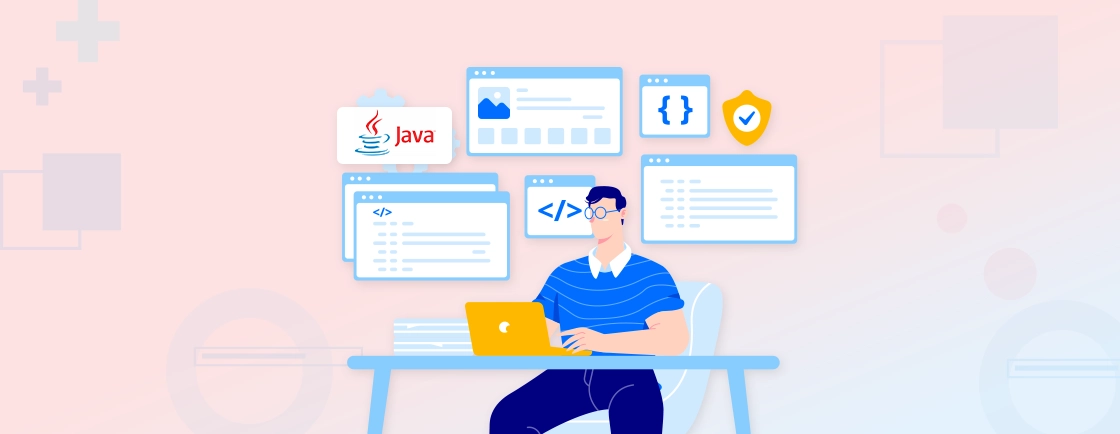Table of Contents
Java is among the best programming languages for building high-quality web applications. And it remains a strong choice when it comes to integrating machine learning to enable systems to learn from data and make intelligent decisions.
Its strong typing, robust ecosystem, and enterprise-friendly features make it ideal for integrating ML into production systems. Java’s extensive libraries cater to diverse needs, from deep learning and data stream processing to traditional algorithms like classification and clustering.
With this blog, you’ll learn about the best Java machine learning library and understand how the Java developers choose the suitable ones for their projects. Let’s begin.
Why Use Java for Machine Learning?
Java’s versatility and maturity have made it a reliable choice for a wide range of applications, and machine learning is no exception. Its ability to handle complex, large-scale systems seamlessly makes it a natural fit for ML projects.
Before diving into the libraries, let’s address why Java is a viable choice for machine learning:
Enterprise Integration
Java’s widespread use in enterprise systems makes it ideal for integrating machine learning functionalities directly into existing applications. This avoids the complexities of cross-language integrations. Many large-scale systems and legacy applications are built on Java, making it a natural fit for adding AI capabilities.
Performance and Scalability
Java’s robust performance, especially with its Just-In-Time (JIT) compilation, is crucial for handling large datasets and computationally intensive machine learning tasks. Its strong multithreading capabilities allow for efficient parallel processing, essential for scaling machine learning models.
Platform Independence
Java’s “write once, run anywhere” principle ensures that machine learning models can be deployed across various platforms without modification, enhancing flexibility and portability.
Mature Ecosystem
Java has a mature and stable ecosystem with extensive libraries and frameworks, providing developers with reliable tools for machine learning development. Java’s security features also are very strong, which is very important with applications that handle sensitive data.
Big Data Compatibility
Java is heavily used in big data technologies like Hadoop and Spark. This makes it a great option for machine learning applications that work with large datasets.
The combination of performance, scalability, and enterprise readiness positions Java as a compelling option for machine learning. Its rich ecosystem and compatibility with distributed computing frameworks further enhance its appeal for building robust ML solutions.
Best Java Machine Learning Libraries
The Java ecosystem boasts a variety of machine learning libraries, each designed to address specific needs and challenges. From deep learning and data stream processing to traditional algorithms, these libraries provide developers with the tools to build, train, and deploy ML models efficiently.
Whether you’re working on a small-scale project or a large, distributed system, there’s a Java library tailored to your requirements.
WEKA
WEKA (Waikato Environment for Knowledge Analysis) is a versatile and user-friendly Java library designed for data mining and machine learning tasks. It provides a comprehensive suite of tools for data preprocessing, classification, regression, clustering, and visualization. With its graphical interface, Weka is ideal for beginners, while its robust API caters to advanced users.
Key Features
- Easy-to-use graphical interface for beginners.
- Supports a wide range of ML algorithms.
- Tools for data preprocessing and feature selection.
- Integration with other Java libraries and frameworks.
Use Cases
- Academic research and education.
- Prototyping ML models.
- Small to medium-scale ML projects.
Its extensive collection of algorithms and compatibility with big data frameworks make it a go-to choice for researchers and developers alike.
Deeplearning4j
Deeplearning4j is tailored for building, training, and deploying deep neural networks in Java. Its focus on enterprise-grade deep learning is evident in its ability to handle large-scale data and complex models.
DL4J’s integration with Hadoop and Spark facilitates distributed training, making it suitable for applications requiring high performance and scalability.
Key Features
- Supports deep learning models like CNNs, RNNs, and GANs.
- GPU acceleration for faster training.
- Integration with Apache Spark for distributed training.
- Built-in support for importing models from Python frameworks like TensorFlow and Keras.
Use Cases
- Deep learning applications like image recognition and NLP.
- Large-scale distributed ML projects.
Its support for various neural network architectures, including convolutional and recurrent networks, caters to diverse deep learning needs.
Apache Spark MLlib
MLlib, integrated into Apache Spark, leverages the power of distributed computing for large-scale machine learning. Its strength lies in its ability to process massive datasets efficiently, making it ideal for big data applications.
MLlib provides a rich set of algorithms for classification, regression, clustering, and collaborative filtering, all optimized for Spark’s distributed environment.
Key Features
- Scalable and distributed ML algorithms.
- Supports classification, regression, clustering, and collaborative filtering.
- Integration with Spark’s data processing capabilities.
Use Cases
- Big data analytics and ML.
- Real-time stream processing.
Its seamless integration with other Spark components simplifies data processing and model deployment in large-scale systems.
MOA
MOA, or Massive Online Analysis, distinguishes itself by its focus on stream mining, enabling real-time analysis of evolving data streams. Its ability to handle concept drift, where the underlying data distribution changes over time, makes it invaluable for applications like fraud detection and network monitoring.
Key Features
- Algorithms for classification, regression, clustering, and outlier detection.
- Tools for evaluating data stream models.
- Integration with Weka for offline analysis.
Use Cases
- Real-time data stream processing.
- Applications like fraud detection and IoT analytics.
MOA’s modular design and extensible framework allow developers to implement custom algorithms and adapt to specific streaming data challenges.
Smile
Smile, or Statistical Machine Intelligence and Learning Engine, emphasizes statistical modeling and machine learning with a strong emphasis on performance and numerical accuracy.
Its comprehensive collection of algorithms for classification, regression, clustering, and visualization, coupled with its efficient implementation, makes it a powerful tool for data analysis.
Key Features
- High-performance implementation of ML algorithms.
- Support for data visualization.
- Easy integration with Java applications.
Use Cases
- General-purpose ML applications.
- Data analysis and visualization.
Smile’s focus on statistical rigor and its ability to handle complex models sets it apart as a robust library for advanced analytics.
Encog
Encog is a Java machine learning framework that supports various machine learning paradigms, including neural networks, support vector machines, and Bayesian networks. Its goal is to provide a comprehensive and easy-to-use platform for building intelligent systems.
Key Features
- Support for neural networks, SVM, and Bayesian networks.
- Tools for data normalization and preprocessing.
- Cross-platform compatibility.
Use Cases
- Neural network-based applications.
- Advanced ML research.
Encog’s cross-platform compatibility and its ability to handle diverse data types make it a versatile tool for developers seeking to integrate machine learning into various applications.
ELKI
ELKI, or Environment for Developing KDD-Applications Supported by Index-Structures, is designed for knowledge discovery in databases, with a focus on clustering and outlier detection. Its strength lies in its extensive collection of algorithms for handling high-dimensional data and complex data structures.
Key Features
- Advanced algorithms for clustering and outlier detection.
- Support for index structures for efficient data processing.
- Extensible architecture for custom algorithms.
Use Cases
- Anomaly detection.
- Clustering and pattern recognition.
ELKI’s emphasis on index structures and its ability to handle large datasets make it suitable for applications requiring advanced data mining capabilities.
JSAT
JSAT (Java Statistical Analysis Tool) provides a collection of statistical analysis and machine learning algorithms, emphasizing efficiency and performance. Its design prioritizes speed and scalability, making it suitable for applications that require fast processing of large datasets.
Key Features
- Wide range of ML algorithms.
- Support for multi-threaded execution.
- Tools for data preprocessing and evaluation.
Use Cases
- Rapid prototyping of ML models.
- Small to medium-scale ML projects.
JSAT’s comprehensive set of algorithms and its focus on numerical accuracy make it a valuable tool for developers seeking to build high-performance machine learning applications.
The flexibility and scalability of these libraries make Java a strong contender in the machine learning space, enabling developers to create innovative solutions that meet the demands of modern applications.
Whether you’re working on a small-scale project or a large, distributed system, there’s a Java library tailored to your requirements. If you need expert guidance or hands-on implementation, our Java Development Company can help you choose the right tools and integrate them seamlessly into your project.
How to Choose the Best Java Machine Learning Library?
Choosing the best Java machine learning library depends on your specific project requirements, technical expertise, and the scale of your application. With numerous options available, each offering unique features and capabilities, it’s essential to evaluate your specific needs and constraints.
When selecting a Java machine learning library, consider the following factors:
- Project Requirements: Identify the specific machine learning tasks you need (e.g., classification, regression, clustering, deep learning). Choose a library that specializes in those areas.
- Ease of Use: Consider the learning curve and documentation quality. Libraries with intuitive APIs and strong community support are ideal for beginners.
- Scalability: For large datasets or real-time processing, opt for libraries that support distributed computing (e.g., Apache Spark MLlib, Deeplearning4j).
- Performance: Evaluate the speed and efficiency of algorithms, especially for time-sensitive applications. Benchmarks and community reviews can provide insights.
- Integration Capabilities: Ensure the library integrates well with your existing tech stack, including databases, big data frameworks, and visualization tools.
- Community and Support: Active communities and regular updates indicate a reliable library. Check forums, GitHub activity, and official documentation for support quality.
- Flexibility and Customization: If you need to implement custom algorithms or modify existing ones, choose a library with modular architecture (e.g., ELKI, Smile).
- Licensing and Cost: Verify the library’s licensing terms to ensure compliance with your project’s legal and financial constraints.
- Algorithm Variety: Libraries with a wide range of algorithms (e.g., Weka, Smile) provide flexibility for diverse use cases.
- Real-Time Processing: For streaming data or real-time analytics, prioritize libraries like MOA or Apache Spark MLlib.
By carefully assessing your project’s requirements and aligning them with the strengths of available libraries, you can make an informed choice that sets your machine learning initiative up for success.
Let’s Summarize
Java’s enduring strengths in performance, scalability, and enterprise integration make it a formidable choice for machine learning projects. With a rich ecosystem of libraries catering to diverse needs–from deep learning and data stream processing to traditional algorithms–Java empowers developers to tackle complex challenges with confidence.
Whether building neural networks, analyzing large datasets, or prototyping new models, the best Java machine learning library can streamline your workflow and enhance your results.
Whether building neural networks, analyzing large datasets, or prototyping new models, the best Java machine learning library can streamline your workflow and enhance your results. To make the most of these capabilities, you can hire Java programmers from our experienced team to develop, optimize, and maintain your machine learning-powered applications.
FAQs on Best Java Machine Learning Library
What is the best Java machine learning library for beginners?
Weka is an excellent choice for beginners due to its user-friendly graphical interface and comprehensive suite of tools for data preprocessing, classification, and visualization. It’s widely used in academic settings and is ideal for prototyping and learning ML concepts.
Is Java suitable for real-time data stream processing?
Yes, Java is well-suited for real-time data stream processing. Libraries like MOA (Massive Online Analysis) are specifically designed for handling continuous data streams, making them ideal for applications like fraud detection and IoT analytics.
Can I import models from Python frameworks into Java?
Yes, libraries like Deeplearning4j allow you to import models trained in Python frameworks such as TensorFlow and Keras. This interoperability makes it easier to leverage existing models and workflows in Java applications.
Are there Java libraries for unsupervised learning and clustering?
Yes, libraries like ELKI and Smile offer advanced algorithms for unsupervised learning, clustering, and outlier detection. These tools are particularly useful for pattern recognition and anomaly detection tasks.
Strengthen Your Java Solutions
Dive into comprehensive tutorials and best practices to enhance your Java development skills.





